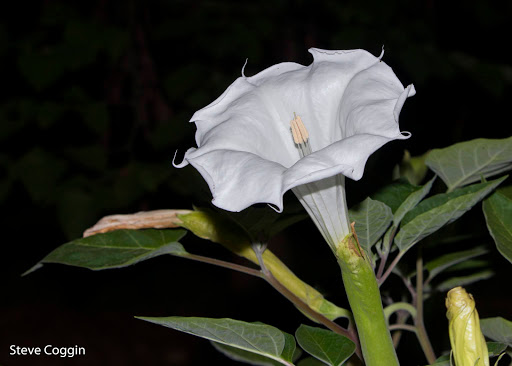 |
| Spurge Nettle (Cnidosculus stimulosus) grows in dry, sandy soil. This plant was one of a group in Weymouth Woods State Park, Moore County, North Carolina. |
When I hear the word nettle, my skin starts to itch. The name accurately describes what these plants do. Brush up against a nettle and you get pain, itching and inflammation. Hairs on the stems and leaves of nettles may contain powerful toxins that cause a painful reaction called urticaria. The plant structures that cause this uncomfortable condition are urticating hairs. There are several plants in the Southeastern United States called nettles, but they are not closely related to each other. All these nettles share a common feature, hairs or spines on the stems and leaves. These structures often contain noxious chemicals and deter grazing animals.
 |
| Solanum carolinense or Horse Nettle is a relative of potato and tomato. Horse Nettle is a common plant in fields and along roadsides. Rowan County, North Carolina. |
 |
| A closeup view of Horse Nettle flowers with their five white petals and five bright yellow anthers. Rowan County, North Carolina. |
Horse Nettle (Solanum carolinense) is a member of the Nightshade family, the Solanaceae. This family family includes many familiar plants; potato (Solanum tubersum) and tomato (Solanum lycopersicum), tobacco (Nicotiana tabacum) and Deadly Nightshade (Atropa belladonna). Horse Nettle is a low-growing herb with lobed leaves. The leaves and stems bear hairs and large hooked spines. Horse Nettle produces blueish-white flowers that have five petals and five bright yellow anthers. The fruits look like yellow cherry tomatoes and each contains dozens of seeds. Horse Nettle is one of the most toxic plants in this part of the world because they produce solanine glycoalkaloids. When ingested solanine glycoalkaloids cause nausea, vomiting, headache and even death. These toxins are in the leaves, stems and fruits, so no part of the plant is safe to consume.
 |
| Horse Nettle leaves and stems have large spines. Rowan County, North Carolina. |
 |
| A maturing fruit of Horse Nettle looking very much like its close relative, tomato. Rowan County, North Carolina |
 |
| The Horse Nettle fruit on the left is nearly ripe. The others will turn yellow in a few days. Rowan County, North Carolina. |
Wood Nettle (Laportea canadensis) is a true nettle in the family Urticaceae. Wood Nettle grows in Eastern North America near water as a member of the forest understory. This plant has large bright green leaves that bear stinging hairs. The hairs break off in the skin and release neurotoxins that cause sharp pain and raise a rash that can last for several days. Despite their threat of pain, many people harvest and eat Wood Nettles. These hardy folks boil the plants and this inactivates the toxins. Wood Nettle is reputed to taste like spinach.
 |
| Wood Nettle plant growing on the flood plain of the Yadkin River. Rowan County, North Carolina. |
 |
| The stinging hairs of Wood Nettle. These fine hairs contain toxins that give a painful sting. Rowan County, North Carolina. |
The third species on this nettle tour is Spurge Nettle. It has a marvelous scientific name, Cnidoscolus simulosus and grasping this
plant is definitely a stimulating experience. Spurge
Nettle is in the family Euphorbiaceae and is primarily a plant of the
Southeastern Coastal Plain where it grows in dry, sandy habitats. This plant has large, dark green, lobed
leaves and produces white flowers with five petals. The fruits of Spurge Nettle are capsules and
each contains three seeds. Of
course, since it is a nettle, the leaves, stems and fruits are covered with
urticating hairs that contain chemical irritants. Spurge Nettle has a large,
starchy taproot that after boiling tastes like pasta.
 |
| Spurge Nettle in flower. Moore County, North Carolina. |
 |
| Flowers and developing fruits of Spurge Nettle. Moore County, North Carolina. |
 |
| Closeup of the utricating hairs of Spurge Nettle. Moore County, North Carolina. |
 |
| The three-chambered fruit of Spurge Nettle. Like the rest of the plant, the fruits are covered with stinging hairs. Moore County, North Carolina. |
People all over the world have a complex relationship with nettles. North American nettles may be poisonous, sting when touched and some are edible. Folk medicine traditions describe many uses of nettle from treating asthma and kidney ailments to preventing baldness. The Tibetan holy man, Milarepa, is said to have lived to a ripe old age in his mountain fastness by eating only nettles. A side effect of this diet was his skin and hair turned green. I make no recommendations on nettles as food or medicine, but they are attention grabbing members of our flora.














